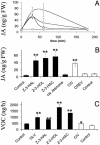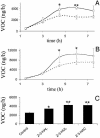Airborne signals prime plants against insect herbivore attack
- PMID: 14749516
- PMCID: PMC341853
- DOI: 10.1073/pnas.0308037100
Airborne signals prime plants against insect herbivore attack
Abstract
Green leafy volatiles (GLV), six-carbon aldehydes, alcohols, and esters commonly emitted by plants in response to mechanical damage or herbivory, induced intact undamaged corn seedlings to rapidly produce jasmonic acid (JA) and emit sesquiterpenes. More importantly, corn seedlings previously exposed to GLV from neighboring plants produced significantly more JA and volatile sesquiterpenes when mechanically damaged and induced with caterpillar regurgitant than seedlings not exposed to GLV. The use of pure synthetic chemicals revealed that (Z)-3-hexenal, (Z)-3-hexen-1-ol, and (Z)-3-hexenyl acetate have nearly identical priming activity. Caterpillar-induced nocturnal volatiles, which are enriched in GLV, also exhibited a strong priming effect, inducing production of larger amounts of JA and release of greater quantities of volatile organic compounds after caterpillar regurgitant application. In contrast, GLV priming did not affect JA production induced by mechanical wounding alone. Thus, GLV specifically prime neighboring plants against impending herbivory by enhancing inducible chemical defense responses triggered during attack and may play a key role in plant-plant signaling and plant-insect interactions.
Figures



References
-
- Karban, R. & Baldwin I. T. (1997) Induced Responses to Herbivory (Univ. of Chicago Press, Chicago).
-
- Takabayashi, J. & Dicke, M. (1996) Trends Plant Sci. 109-113.
-
- Turlings, T. C. J., Tumlinson, J. H., Heath, R. R., Proveaux, A. T. & Doolittle, R. E. J. (1991) Chem. Ecol. 17, 2235-2251. - PubMed
-
- DeMoraes, C. M., Mescher, M. C. & Tumlinson, J. H. (2001) Nature 410, 577-580. - PubMed
-
- Kessler, A. & Baldwin, I. T. (2001) Science 291, 2141-2144. - PubMed
Publication types
MeSH terms
Substances
LinkOut - more resources
Full Text Sources
Other Literature Sources

